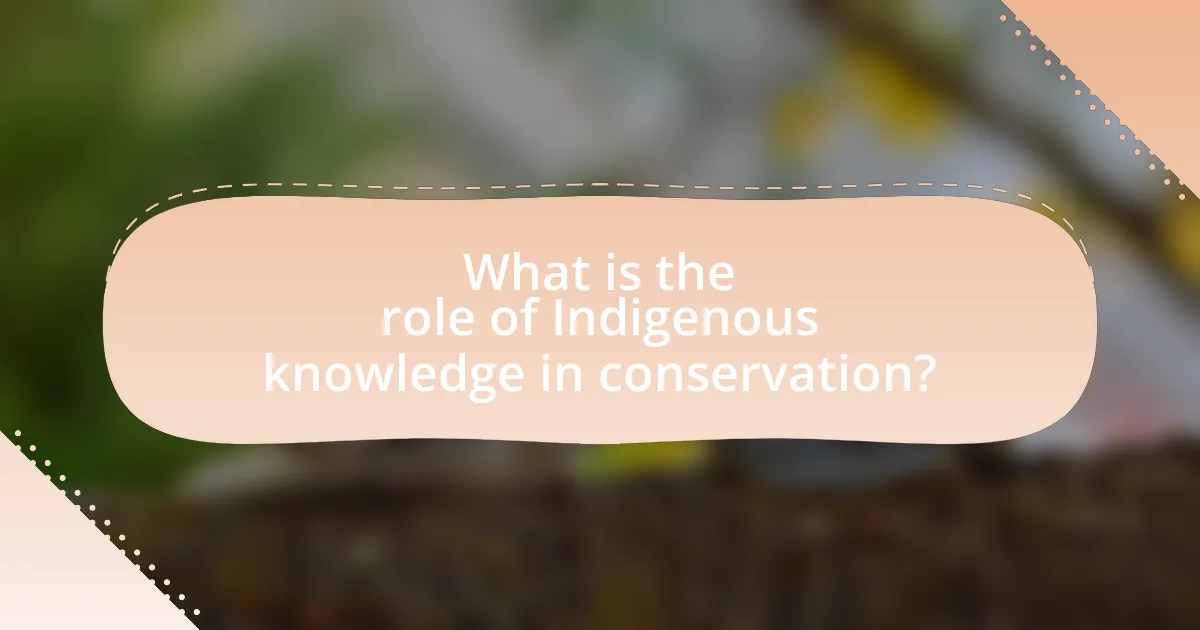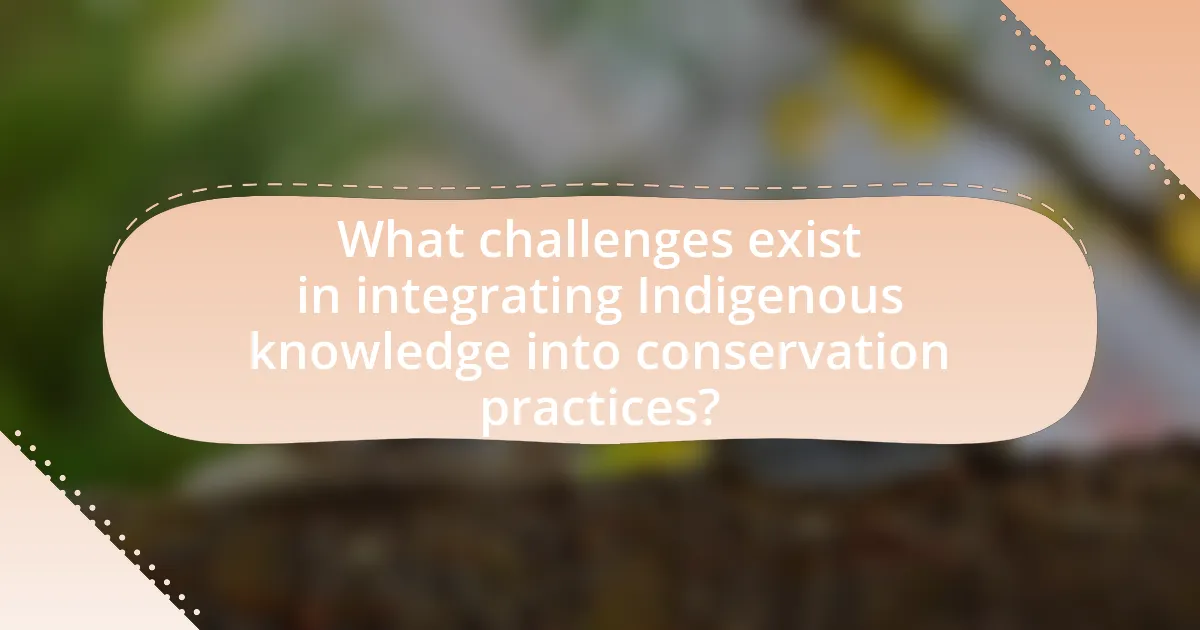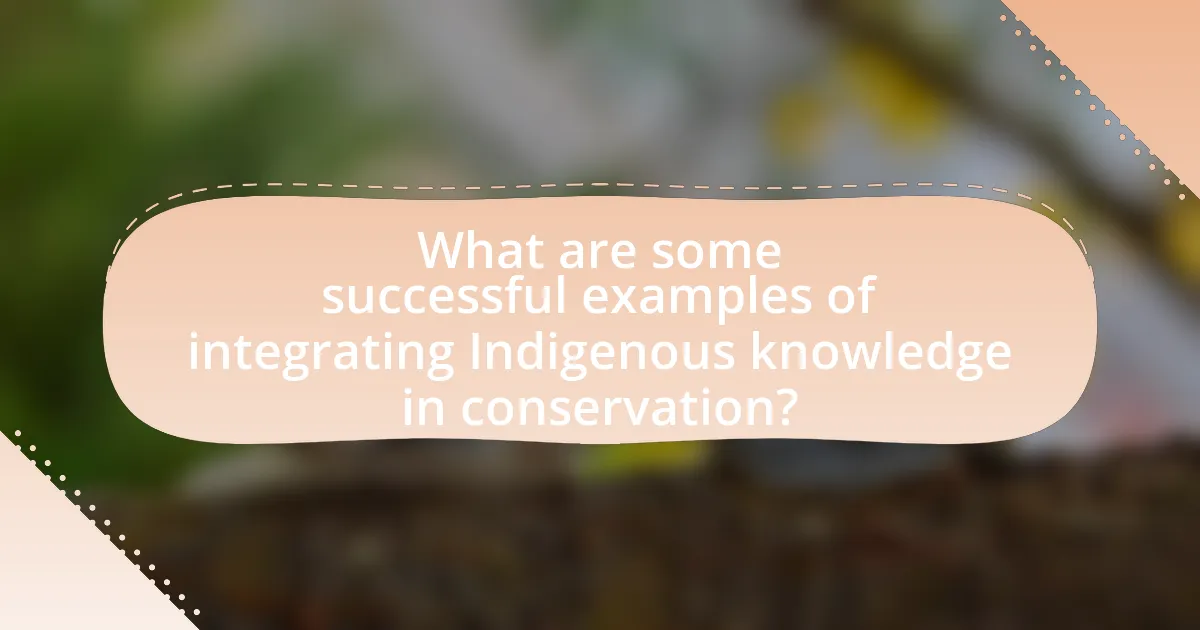The article focuses on the integration of Indigenous knowledge into conservation practices, highlighting its significance in promoting sustainable land management and enhancing biodiversity. It contrasts Indigenous knowledge with Western scientific approaches, emphasizing its holistic and experiential nature rooted in cultural and historical contexts. Key principles of Indigenous knowledge systems, such as relationality and sustainability, are discussed, along with the influence of cultural practices on conservation efforts. The article also addresses the challenges and barriers to collaboration between Indigenous communities and conservationists, including historical injustices and differing worldviews, while presenting successful case studies that demonstrate the effectiveness of integrating Indigenous knowledge in conservation strategies.

What is the role of Indigenous knowledge in conservation?
Indigenous knowledge plays a crucial role in conservation by providing insights into sustainable land management practices that have been developed over generations. This knowledge encompasses traditional ecological understanding, which includes species behavior, ecosystem dynamics, and resource management techniques that are often more effective in local contexts than conventional scientific approaches. For instance, studies have shown that Indigenous land management practices, such as controlled burns, can enhance biodiversity and reduce the risk of catastrophic wildfires. The integration of Indigenous knowledge into conservation strategies not only respects cultural heritage but also improves ecological outcomes, as evidenced by successful collaborations in various regions, including Australia and North America, where Indigenous stewardship has led to the restoration of ecosystems and increased resilience to climate change.
How does Indigenous knowledge differ from Western scientific approaches?
Indigenous knowledge differs from Western scientific approaches primarily in its holistic and experiential nature. Indigenous knowledge is rooted in the cultural, spiritual, and historical contexts of specific communities, emphasizing relationships with the land and ecosystems over time. In contrast, Western scientific approaches prioritize empirical evidence, experimentation, and objective analysis, often isolating variables to understand phenomena.
For example, Indigenous practices in land management, such as controlled burns, are informed by generations of observation and interaction with the environment, while Western science may focus on quantitative data and models to predict ecological outcomes. This fundamental difference highlights the value of integrating both knowledge systems for effective conservation strategies, as seen in collaborative projects that combine traditional ecological knowledge with scientific research to enhance biodiversity and sustainability.
What are the key principles of Indigenous knowledge systems?
The key principles of Indigenous knowledge systems include holistic understanding, relationality, sustainability, and oral tradition. Holistic understanding emphasizes the interconnectedness of all elements within ecosystems, recognizing that social, cultural, and environmental factors are interdependent. Relationality highlights the importance of relationships among people, communities, and the natural world, fostering a sense of responsibility and stewardship. Sustainability focuses on practices that ensure the long-term health of ecosystems and communities, often guided by traditional ecological knowledge. Oral tradition serves as a means of preserving and transmitting knowledge across generations, ensuring that cultural practices and ecological wisdom are maintained. These principles are foundational in guiding Indigenous approaches to conservation and resource management.
How do cultural practices influence conservation efforts?
Cultural practices significantly influence conservation efforts by shaping community values and behaviors towards natural resources. For instance, Indigenous communities often have traditional ecological knowledge that promotes sustainable practices, such as rotational farming and sacred sites that protect biodiversity. Research indicates that areas managed by Indigenous peoples show higher biodiversity levels, as seen in the Amazon rainforest, where Indigenous land stewardship has preserved ecosystems for centuries. This integration of cultural practices into conservation strategies enhances the effectiveness of efforts by fostering local engagement and respect for the environment.
Why is integrating Indigenous knowledge important for future conservation?
Integrating Indigenous knowledge is crucial for future conservation because it encompasses centuries of ecological understanding and sustainable practices that have proven effective in managing natural resources. Indigenous communities possess unique insights into local ecosystems, biodiversity, and climate patterns, which can enhance conservation strategies. For instance, studies have shown that areas managed by Indigenous peoples often exhibit higher biodiversity and resilience to climate change compared to those managed by conventional methods. This is supported by research from the United Nations Environment Programme, which highlights that Indigenous lands contain about 80% of the world’s remaining biodiversity. Therefore, incorporating Indigenous knowledge not only respects cultural heritage but also significantly contributes to more effective and sustainable conservation efforts.
What are the potential benefits of this integration?
The potential benefits of integrating Indigenous knowledge into conservation efforts include enhanced biodiversity preservation and improved ecosystem management. Indigenous practices often emphasize sustainable resource use and a deep understanding of local ecosystems, which can lead to more effective conservation strategies. For instance, studies have shown that areas managed by Indigenous communities often exhibit higher levels of biodiversity compared to those managed by conventional methods. This integration can also foster community engagement and support, as Indigenous peoples are more likely to participate in conservation initiatives that respect their cultural practices and knowledge systems.
How can Indigenous knowledge enhance biodiversity conservation?
Indigenous knowledge can enhance biodiversity conservation by providing a deep understanding of local ecosystems and sustainable practices developed over generations. This knowledge includes traditional ecological practices, species management, and habitat preservation techniques that have proven effective in maintaining biodiversity. For example, Indigenous fire management practices, such as controlled burns, have been shown to promote healthy ecosystems and reduce the risk of catastrophic wildfires, as evidenced by studies in Australia where Indigenous land management has led to improved biodiversity outcomes. Additionally, Indigenous communities often have a holistic view of nature, recognizing the interconnectedness of species and ecosystems, which can inform more effective conservation strategies.

What challenges exist in integrating Indigenous knowledge into conservation practices?
Integrating Indigenous knowledge into conservation practices faces several challenges, primarily due to differing worldviews and communication barriers. Indigenous knowledge systems often emphasize holistic and relational understandings of ecosystems, which can conflict with Western scientific approaches that prioritize quantitative data and individual species management. Additionally, historical marginalization of Indigenous communities leads to mistrust, making collaboration difficult. A study by Davis and Slobodkin (2020) highlights that effective integration requires mutual respect and recognition of Indigenous rights, which are often overlooked in conservation policies. Furthermore, legal and institutional frameworks frequently do not accommodate Indigenous governance structures, complicating the implementation of collaborative conservation efforts.
What are the barriers to collaboration between Indigenous communities and conservationists?
Barriers to collaboration between Indigenous communities and conservationists include differing worldviews, historical mistrust, and lack of recognition of Indigenous rights. Indigenous communities often prioritize cultural and spiritual connections to land, while conservationists may focus on ecological metrics, leading to conflicting objectives. Historical injustices, such as land dispossession and marginalization, have fostered mistrust towards external conservation efforts. Additionally, many conservation initiatives do not adequately recognize or incorporate Indigenous rights and governance systems, further complicating partnerships. These factors create significant challenges in establishing effective collaboration for conservation efforts.
How do historical injustices impact current conservation efforts?
Historical injustices significantly hinder current conservation efforts by fostering distrust between Indigenous communities and conservation organizations. This distrust stems from historical experiences of land dispossession, cultural erasure, and exclusion from decision-making processes, which have led to a reluctance among Indigenous peoples to engage with external conservation initiatives. For instance, the establishment of national parks often involved the forced removal of Indigenous populations, as seen in the creation of Yellowstone National Park in 1872, which displaced Native American tribes. Consequently, this historical context complicates collaborative conservation efforts, as Indigenous knowledge and practices, which are crucial for effective biodiversity management, are often overlooked or undervalued. The lack of meaningful partnerships with Indigenous communities can result in ineffective conservation strategies that fail to address local ecological and cultural needs.
What role does policy play in facilitating or hindering integration?
Policy plays a crucial role in either facilitating or hindering integration by establishing frameworks that govern the inclusion of diverse knowledge systems, such as Indigenous knowledge, in conservation efforts. Effective policies can promote collaboration between Indigenous communities and conservation organizations, ensuring that traditional ecological knowledge is recognized and utilized in environmental management. For instance, the United Nations Declaration on the Rights of Indigenous Peoples emphasizes the importance of Indigenous participation in decision-making processes, which can enhance integration efforts. Conversely, policies that overlook or marginalize Indigenous perspectives can create barriers, leading to conflicts and ineffective conservation strategies. Therefore, the design and implementation of inclusive policies are essential for successful integration in conservation practices.
How can these challenges be addressed effectively?
Integrating Indigenous knowledge into conservation efforts can effectively address challenges by fostering collaboration between Indigenous communities and conservation organizations. This collaboration ensures that traditional ecological knowledge is respected and utilized, leading to more sustainable practices. For instance, studies have shown that areas managed by Indigenous peoples often exhibit higher biodiversity and resilience to climate change, as evidenced by research published in the journal “Nature” which highlights the success of Indigenous-led conservation initiatives in Australia. By prioritizing Indigenous voices and practices, conservation strategies can become more inclusive and effective, ultimately benefiting both ecosystems and local communities.
What strategies have proven successful in overcoming integration barriers?
Successful strategies for overcoming integration barriers in the context of integrating Indigenous knowledge into conservation include fostering collaborative partnerships, ensuring mutual respect, and implementing inclusive decision-making processes. Collaborative partnerships between Indigenous communities and conservation organizations have been shown to enhance trust and facilitate knowledge exchange, as evidenced by initiatives like the Great Bear Rainforest project in British Columbia, where Indigenous stewardship has led to effective conservation outcomes. Ensuring mutual respect involves recognizing and valuing Indigenous knowledge systems alongside scientific approaches, which has been demonstrated in various case studies, such as the integration of traditional ecological knowledge in fire management practices in Australia. Lastly, inclusive decision-making processes that actively involve Indigenous voices in policy development have proven effective, as seen in the co-management frameworks established in places like the Arctic, where local knowledge significantly informs resource management strategies.
How can education and awareness promote better collaboration?
Education and awareness can promote better collaboration by equipping individuals with the knowledge and understanding necessary to appreciate diverse perspectives, particularly in the context of integrating Indigenous knowledge in conservation efforts. When stakeholders are educated about the cultural significance and ecological wisdom embedded in Indigenous practices, they are more likely to engage in respectful dialogue and cooperative initiatives. Research indicates that collaborative conservation efforts that incorporate Indigenous knowledge lead to more effective environmental management outcomes, as seen in case studies where Indigenous communities have successfully partnered with governmental and non-governmental organizations. This mutual understanding fosters trust and shared goals, ultimately enhancing the effectiveness of conservation strategies.

What are some successful examples of integrating Indigenous knowledge in conservation?
Successful examples of integrating Indigenous knowledge in conservation include the collaborative management of national parks in Australia, where Indigenous land management practices have been incorporated into fire management strategies, leading to improved biodiversity outcomes. For instance, the “Caring for Country” program in the Northern Territory utilizes traditional ecological knowledge to enhance land stewardship, resulting in healthier ecosystems and the revival of endangered species. Additionally, the integration of Indigenous fishing practices in the management of marine protected areas in Canada has demonstrated sustainable fishing practices that respect traditional knowledge while ensuring the conservation of marine biodiversity. These examples highlight the effectiveness of combining Indigenous knowledge with scientific approaches to achieve conservation goals.
How have Indigenous-led conservation initiatives impacted ecosystems?
Indigenous-led conservation initiatives have significantly enhanced ecosystem health and biodiversity. These initiatives often incorporate traditional ecological knowledge, which has been shown to promote sustainable land management practices. For instance, a study published in the journal “Nature” by Berkes and Folke (1998) highlights how Indigenous practices, such as controlled burns and rotational hunting, have maintained the balance of ecosystems for centuries. Additionally, the Indigenous Guardians program in Canada has demonstrated effective monitoring and protection of wildlife habitats, leading to increased populations of species like caribou and salmon. These examples illustrate that Indigenous-led efforts not only preserve cultural heritage but also contribute to the resilience and sustainability of ecosystems.
What specific case studies demonstrate successful integration?
The case study of the Kuku Yalanji people in Australia demonstrates successful integration of Indigenous knowledge into conservation practices. This community collaborated with the Queensland Parks and Wildlife Service to manage the Daintree National Park, utilizing traditional ecological knowledge to enhance biodiversity and ecosystem health. Their approach included controlled burning practices that mimic natural fire regimes, which have been shown to reduce invasive species and promote native flora. Additionally, the integration of Indigenous perspectives in land management has led to improved cultural heritage preservation and community engagement, as evidenced by increased participation in conservation efforts and positive ecological outcomes.
How do these examples inform future conservation strategies?
Examples of integrating Indigenous knowledge into conservation strategies demonstrate the effectiveness of traditional ecological practices in biodiversity preservation. For instance, Indigenous land management techniques, such as controlled burns, have been shown to enhance ecosystem resilience and reduce wildfire risks, as evidenced by studies in Australia where these methods improved habitat health and species diversity. By incorporating these practices, future conservation strategies can leverage local ecological knowledge, leading to more sustainable and culturally relevant approaches that align with both environmental goals and community needs.
What lessons can be learned from these successful integrations?
Successful integrations of Indigenous knowledge into conservation practices demonstrate the importance of collaboration and respect for traditional ecological wisdom. These integrations reveal that engaging Indigenous communities leads to more effective and sustainable environmental management, as evidenced by projects like the Great Bear Rainforest initiative in Canada, where Indigenous stewardship has resulted in improved biodiversity outcomes. Additionally, these successful cases highlight the necessity of recognizing Indigenous rights and governance structures, which fosters trust and enhances the effectiveness of conservation efforts.
How can these lessons be applied to other conservation contexts?
Lessons from integrating Indigenous knowledge can be applied to other conservation contexts by emphasizing community involvement and traditional ecological practices. For instance, Indigenous methods often prioritize sustainable resource management, which can enhance biodiversity and ecosystem resilience in various regions. Research shows that areas managed with Indigenous practices, such as fire management in Australia, have lower risks of catastrophic wildfires and improved habitat conditions. This evidence supports the idea that incorporating local knowledge and practices can lead to more effective conservation strategies across different ecosystems.
What best practices should be adopted for future initiatives?
Future initiatives in conservation should adopt best practices that prioritize the integration of Indigenous knowledge systems. This approach enhances ecological understanding and fosters sustainable practices rooted in local traditions. Evidence shows that Indigenous communities have managed ecosystems effectively for centuries, utilizing practices that promote biodiversity and resilience. For instance, the use of controlled burns by Indigenous peoples in North America has been shown to reduce wildfire risks and enhance habitat diversity, as documented in studies by the U.S. Forest Service. Additionally, collaborative governance models that include Indigenous voices in decision-making processes have been proven to lead to more effective conservation outcomes, as highlighted in the report “Indigenous Peoples and Conservation” by the International Union for Conservation of Nature. These practices not only respect cultural heritage but also leverage traditional ecological knowledge to address contemporary environmental challenges.
What practical steps can be taken to support the integration of Indigenous knowledge in conservation?
Practical steps to support the integration of Indigenous knowledge in conservation include establishing collaborative partnerships between Indigenous communities and conservation organizations. These partnerships should prioritize mutual respect and recognition of Indigenous rights, ensuring that Indigenous voices are included in decision-making processes. Additionally, incorporating Indigenous knowledge into conservation planning and management can enhance biodiversity outcomes, as evidenced by studies showing that Indigenous land management practices often lead to healthier ecosystems. Training programs that educate conservation practitioners about Indigenous knowledge systems can further facilitate this integration, fostering a more inclusive approach to conservation efforts.
How can stakeholders engage with Indigenous communities effectively?
Stakeholders can engage with Indigenous communities effectively by prioritizing respectful communication and building trust through long-term relationships. Establishing open dialogue allows stakeholders to understand the unique cultural values and traditional knowledge of Indigenous peoples, which is essential for collaborative conservation efforts. Research indicates that projects incorporating Indigenous perspectives lead to more sustainable outcomes, as seen in the case of the Great Bear Rainforest in British Columbia, where Indigenous stewardship significantly contributed to ecological preservation. Engaging Indigenous communities in decision-making processes ensures their voices are heard and respected, fostering a sense of ownership and responsibility towards conservation initiatives.
What resources are available for promoting Indigenous knowledge in conservation efforts?
Resources available for promoting Indigenous knowledge in conservation efforts include collaborative frameworks, educational programs, and funding initiatives. Collaborative frameworks, such as the Indigenous Peoples’ Climate Change Assessment, facilitate partnerships between Indigenous communities and conservation organizations, ensuring that traditional ecological knowledge is integrated into conservation strategies. Educational programs, like those offered by the Indigenous Environmental Network, provide training on sustainable practices rooted in Indigenous traditions. Additionally, funding initiatives, such as the Indigenous Land Stewardship Grant Program, support projects that prioritize Indigenous-led conservation efforts, thereby validating and promoting Indigenous knowledge in environmental stewardship.